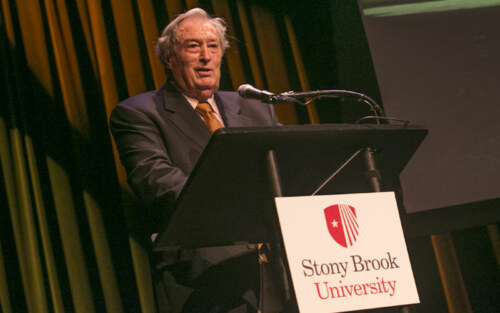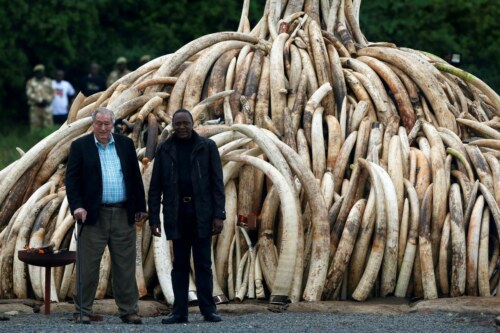World-renowned paleoanthropologist and conservationist Richard E. Leakey, chair of the Turkana Basin Institute (TBI) and a professor in the Stony Brook University Department of Anthropology in the College of Arts and Sciences died January 2 at the age of 77.
Leakey devoted the majority of his life to research on human origins, conservation of wildlife and public service, and his paleontological discoveries helped prove how humankind evolved in Africa.
Leakey’s family, through his daughter, Samira, released a statement, on January 3rd, on his passing.
Leakey is survived by his wife, Meave Leakey, co-director of Koobi Fora Research Project and a research professor in Stony Brook’s Department of Anthropology, and three children, including TBI Louise Leakey. Tributes may be left online at the ForeverMissed memorial site.
“It’s a tragic loss for humankind,” said TBI Director Lawrence Martin in a televised interview with the BBC. “Richard was a visionary. His advocacy for the environment and his role in raising scientific awareness about the African origins of humankind was quite an extraordinary contribution. He was also the most wonderful, loyal friend you could ever hope to meet.”
“I am deeply saddened by the news of Dr. Leakey’s passing, and send my condolences to his loving family, friends, colleagues, and the many people he inspired,” said Stony Brook University President Maurie McInnis. “I cannot think of a scholar more reverent of life, dedicated as he was both to the understanding of the origins of humans and the conservation of wildlife. His groundbreaking discoveries and his establishment of the Turkana Basin Institute, of which Stony Brook is the proud academic affiliate, have given us innumerable insights into the origins and evolution of humanity. We have lost a transformational scholar — a man who changed the way we think about ourselves. Stony Brook was honored to be his academic home.”
Leakey was born December 19, 1944, in Nairobi, Kenya. His mother, Mary Leakey, discovered evidence in 1978 that man walked upright much earlier than had been thought. She and her husband, Louis Leakey, unearthed skulls of ape-like early humans.
By age 23, Leakey had already made a discovery about the earliest Homo Sapiens. During a 1967 expedition in Ethiopia’s Omo Valley, he found two partial fossil hominin skulls, Omo I and Omo II. Confirmed by geological dating efforts, these two specimens are the oldest fossils of Homo sapiens yet to be found (195,000 years), supporting the theory that East Africa is the birthplace of modern humans.
Between 1968 and 1989, Leakey coordinated field expeditions to the eastern and western shores of Lake Turkana, and was appointed as the first director of Kenya’s National Museums.
Initially gaining worldwide fame for the 1972 discovery of “1470,” a complete skull of early Homo erectus, Leakey was featured on the cover of Time magazine in 1977. Working with Meave Leakey, the groundbreaking discoveries in northern Kenya continued, and in 1984, Leakey and his team recovered the nearly complete 1.6-million-year-old skeleton of a Homo erectus youth — known as “Nariokotome Boy” or “Turkana Boy” — a major contribution to the study of evolutionary biology.
Leakey was also dedicated to the conservation of wildlife. In 1989, he became founding director of the Kenyan Wildlife Conservation and Management Department, which later became known as the Kenya Wildlife Service. Kenyan President Daniel arap Moi appointed him to lead the Kenya Wildlife Service in response to the national elephant poaching crisis.
As a director, Leakey reorganized the country’s national park systems and dramatically reduced poaching levels. Leakey also made international headlines in 1989 after leading the initiative to burn Kenya’s stockpile of 12 tons of ivory, worth an estimated $3 million dollars, making a profound statement against the ivory trade.
In 1995, Leakey founded the political party Safina (Swahili for “ark”) and swore to fight corruption in Kenya. Two years later, he became a member of the Kenyan Parliament and then later was head of the Public Service and secretary to the cabinet
Leakey received an honorary degree from Stony Brook University and in 2002 accepted the position of visiting professor of anthropology, having resigned from politics. He soon shared an idea he’d had for a long time: to build a permanent research facility in the Turkana Basin to assist scientists with the logistics of working in such a challenging, yet rewarding place.

Richard Leakey speaking at the Stony Brook University where he received an honorary degree.
IMAGE / Stony Brook University
In 2005, Leakey partnered with Stony Brook to create TBI, a collaborative, international, multi-disciplinary organization that facilitates scientific research in the Turkana Basin region of northern Kenya. At TBI, he inspired students to become the next generation of earth and natural sciences while supporting further research in the region.
In 2015, President Uhuru Kenyatta appointed Leakey chairman of the board of the Kenya Wildlife Service, more than two decades after he resigned as the director in January 1994.

Kenyan President Uhuru Kenyatta (right) and chairman of the Kenyan Wildlife Service (KWS) Richard Leakey (left) pose for the press after the president lit on fire parts of an estimated 105 tonnes of ivory and a tonne of rhino horn confiscated from smugglers and poachers at the Nairobi National Park near Nairobi, Kenya, April 30, 2016. REUTERS/Siegfried Modola/File Photo
Leakey was inducted as an honorary fellow into the African Academy of Sciences (AAS) in 2020.
At the time of Leakey’s death, he was working on a project of building a museum on the edges of Kenya’s Rift Valley, named Ngaren, to celebrate evolution and the common history from Africa that all humans share.
